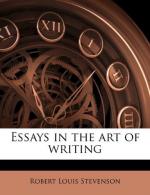’In Xanady did Kubla Khan (KANDL)
A stately pleasure dome decree, (KDLSR)
Where Alph the sacred river ran, (KANDLSR)
Through caverns measureless to man, (KANLSR)
Down to a sunless sea.’ {6} (NDLS)
Here I have put the analysis of the main group alongside the lines; and the more it is looked at, the more interesting it will seem. But there are further niceties. In lines two and four, the current S is most delicately varied with Z. In line three, the current flat A is twice varied with the open A, already suggested in line two, and both times (’where’ and ‘sacred’) in conjunction with the current R. In the same line F and V (a harmony in themselves, even when shorn of their comrade P) are admirably contrasted. And in line four there is a marked subsidiary M, which again was announced in line two. I stop from weariness, for more might yet be said.
My next example was recently quoted from Shakespeare as an example of the poet’s colour sense. Now, I do not think literature has anything to do with colour, or poets anyway the better of such a sense; and I instantly attacked this passage, since ‘purple’ was the word that had so pleased the writer of the article, to see if there might not be some literary reason for its use. It will be seen that I succeeded amply; and I am bound to say I think the passage exceptional in Shakespeare—exceptional, indeed, in literature; but it was not I who chose it.
’The BaRge she sat iN, like a BURNished throNe
Burnt oN the water: the poop was BeateN
gold,
PURPle the sails and so PUR* Fumed that * per
The wiNds were love-sick with them.’ {7}
It may be asked why I have put the F of ‘perfumed’ in capitals; and I reply, because this change from P to F is the completion of that from B to P, already so adroitly carried out. Indeed, the whole passage is a monument of curious ingenuity; and it seems scarce worth while to indicate the subsidiary S, L, and W. In the same article, a second passage from Shakespeare was quoted, once again as an example of his colour sense:
’A mole cinque-spotted like the crimson drops I’ the bottom of a cowslip.’ {8}
It is very curious, very artificial, and not worth while to analyse at length: I leave it to the reader. But before I turn my back on Shakespeare, I should like to quote a passage, for my own pleasure, and for a very model of every technical art:
But in the wind and tempest of her frown,
W. P. V.{9} F. (st) (ow)
Distinction with a loud and powerful fan,
W.P. F. (st) (ow) L.
Puffing at all, winnows the light away;
W. P. F. L.
And what hath mass and matter by itself
W. F. L. M. A.
Lies rich in virtue and unmingled.’ {10}
V. L. M.
From these delicate and choice writers I turned with some curiosity to a player of the big drum—Macaulay. I had in hand the two-volume edition, and I opened at the beginning of the second volume. Here was what I read:




